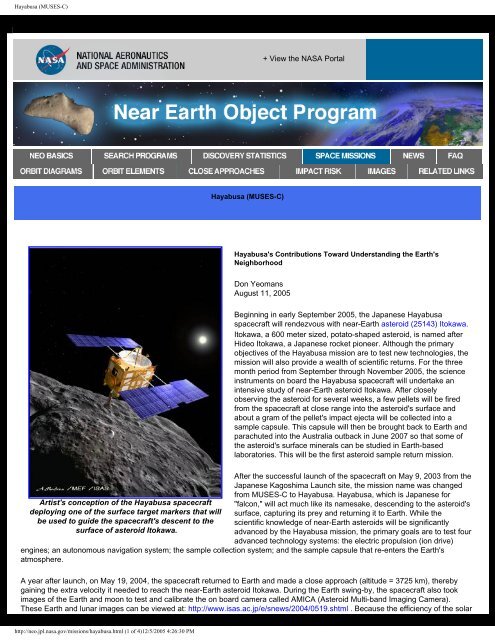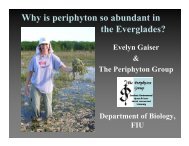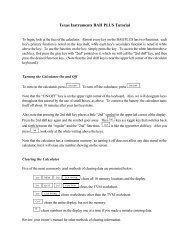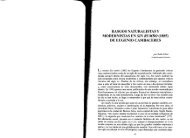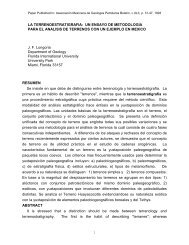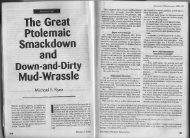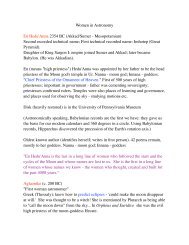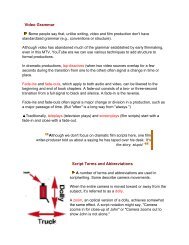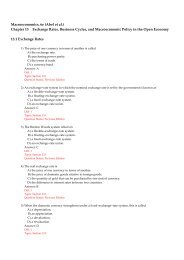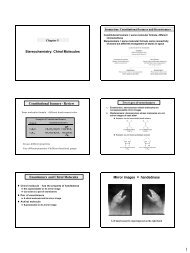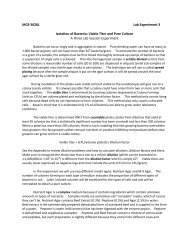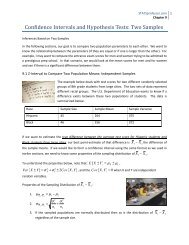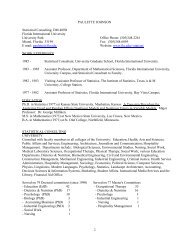- Page 1 and 2: Asteroid Comet Impact Hazards 12/5/
- Page 3 and 4: Asteroid Comet Impact Hazards: Intr
- Page 5 and 6: Asteroids, Comets and NASA Research
- Page 7 and 8: Torino Impact Scale 12/5/2005 Torin
- Page 9 and 10: Torino Impact Scale with newly disc
- Page 11 and 12: Torino Impact Scale approach. It ma
- Page 13 and 14: NASA Astrobiology Institute Feature
- Page 15: Near-Earth Object Program Artist's
- Page 19 and 20: Hayabusa (MUSES-C) beyond Earth. Ad
- Page 21 and 22: Bibliography 12/5/2005 Asteroid and
- Page 23 and 24: Bibliography Solem, and D.G. Rather
- Page 25 and 26: Bibliography University of Arizona
- Page 27 and 28: Bibliography Scheeres, D.J., S.J. O
- Page 29 and 30: Bibliography ordinary chondrite met
- Page 31 and 32: Bibliography Chyba, C.F., G.E. van
- Page 33 and 34: Bibliography Bottke, W. F., D. C. R
- Page 35 and 36: Bibliography Poveda, A., M.A. Herre
- Page 37 and 38: Bibliography Chicxulub Crater. J. G
- Page 39 and 40: Neo Catalog 12/5/2005 NEO Catalog h
- Page 41 and 42: Unusual Minor Planets Unusual Minor
- Page 43 and 44: Forthcoming Close Approaches To The
- Page 45 and 46: Forthcoming Close Approaches To The
- Page 47 and 48: Forthcoming Close Approaches To The
- Page 49 and 50: Forthcoming Close Approaches To The
- Page 51 and 52: Forthcoming Close Approaches To The
- Page 53 and 54: Forthcoming Close Approaches To The
- Page 55 and 56: Forthcoming Close Approaches To The
- Page 57 and 58: Forthcoming Close Approaches To The
- Page 59 and 60: Forthcoming Close Approaches To The
- Page 61 and 62: Forthcoming Close Approaches To The
- Page 63 and 64: Forthcoming Close Approaches To The
- Page 65 and 66: Forthcoming Close Approaches To The
- Page 67 and 68:
Forthcoming Close Approaches To The
- Page 69 and 70:
Forthcoming Close Approaches To The
- Page 71 and 72:
Forthcoming Close Approaches To The
- Page 73 and 74:
Forthcoming Close Approaches To The
- Page 75 and 76:
Forthcoming Close Approaches To The
- Page 77 and 78:
Forthcoming Close Approaches To The
- Page 79 and 80:
Forthcoming Close Approaches To The
- Page 81 and 82:
Forthcoming Close Approaches To The
- Page 83 and 84:
Forthcoming Close Approaches To The
- Page 85 and 86:
Forthcoming Close Approaches To The
- Page 87 and 88:
Forthcoming Close Approaches To The
- Page 89 and 90:
Forthcoming Close Approaches To The
- Page 91 and 92:
Forthcoming Close Approaches To The
- Page 93 and 94:
Forthcoming Close Approaches To The
- Page 95 and 96:
Forthcoming Close Approaches To The
- Page 97 and 98:
Forthcoming Close Approaches To The
- Page 99 and 100:
Forthcoming Close Approaches To The
- Page 101 and 102:
Forthcoming Close Approaches To The
- Page 103 and 104:
Forthcoming Close Approaches To The
- Page 105 and 106:
Forthcoming Close Approaches To The
- Page 107 and 108:
Forthcoming Close Approaches To The
- Page 109 and 110:
Forthcoming Close Approaches To The
- Page 111 and 112:
Forthcoming Close Approaches To The
- Page 113 and 114:
Forthcoming Close Approaches To The
- Page 115 and 116:
Forthcoming Close Approaches To The
- Page 117 and 118:
Forthcoming Close Approaches To The
- Page 119 and 120:
Forthcoming Close Approaches To The
- Page 121 and 122:
Forthcoming Close Approaches To The
- Page 123 and 124:
Forthcoming Close Approaches To The
- Page 125 and 126:
Forthcoming Close Approaches To The
- Page 127 and 128:
Forthcoming Close Approaches To The
- Page 129 and 130:
Forthcoming Close Approaches To The
- Page 131 and 132:
Forthcoming Close Approaches To The
- Page 133 and 134:
Forthcoming Close Approaches To The
- Page 135 and 136:
Forthcoming Close Approaches To The
- Page 137 and 138:
Forthcoming Close Approaches To The
- Page 139 and 140:
Forthcoming Close Approaches To The
- Page 141 and 142:
Forthcoming Close Approaches To The
- Page 143 and 144:
Forthcoming Close Approaches To The
- Page 145 and 146:
Forthcoming Close Approaches To The
- Page 147 and 148:
Forthcoming Close Approaches To The
- Page 149 and 150:
Forthcoming Close Approaches To The
- Page 151 and 152:
Forthcoming Close Approaches To The
- Page 153 and 154:
Forthcoming Close Approaches To The
- Page 155 and 156:
Forthcoming Close Approaches To The
- Page 157 and 158:
Forthcoming Close Approaches To The
- Page 159 and 160:
Forthcoming Close Approaches To The
- Page 161 and 162:
Forthcoming Close Approaches To The
- Page 163 and 164:
Forthcoming Close Approaches To The
- Page 165 and 166:
Forthcoming Close Approaches To The
- Page 167 and 168:
Forthcoming Close Approaches To The
- Page 169 and 170:
Forthcoming Close Approaches To The
- Page 171 and 172:
Forthcoming Close Approaches To The
- Page 173 and 174:
Forthcoming Close Approaches To The
- Page 175 and 176:
Forthcoming Close Approaches To The
- Page 177 and 178:
Forthcoming Close Approaches To The
- Page 179 and 180:
Forthcoming Close Approaches To The
- Page 181 and 182:
Forthcoming Close Approaches To The
- Page 183 and 184:
Forthcoming Close Approaches To The
- Page 185 and 186:
Forthcoming Close Approaches To The
- Page 187 and 188:
Forthcoming Close Approaches To The
- Page 189 and 190:
Forthcoming Close Approaches To The
- Page 191 and 192:
Forthcoming Close Approaches To The
- Page 193 and 194:
Forthcoming Close Approaches To The
- Page 195 and 196:
Forthcoming Close Approaches To The
- Page 197 and 198:
Forthcoming Close Approaches To The
- Page 199 and 200:
Forthcoming Close Approaches To The
- Page 201 and 202:
Forthcoming Close Approaches To The
- Page 203 and 204:
Forthcoming Close Approaches To The
- Page 205 and 206:
Forthcoming Close Approaches To The
- Page 207 and 208:
Forthcoming Close Approaches To The
- Page 209 and 210:
Forthcoming Close Approaches To The
- Page 211 and 212:
Forthcoming Close Approaches To The
- Page 213 and 214:
Forthcoming Close Approaches To The
- Page 215 and 216:
Forthcoming Close Approaches To The
- Page 217 and 218:
Forthcoming Close Approaches To The
- Page 219 and 220:
Forthcoming Close Approaches To The
- Page 221 and 222:
Forthcoming Close Approaches To The
- Page 223 and 224:
Forthcoming Close Approaches To The
- Page 225 and 226:
Forthcoming Close Approaches To The
- Page 227 and 228:
Forthcoming Close Approaches To The
- Page 229 and 230:
Forthcoming Close Approaches To The
- Page 231 and 232:
Forthcoming Close Approaches To The
- Page 233 and 234:
Forthcoming Close Approaches To The
- Page 235 and 236:
Forthcoming Close Approaches To The
- Page 237 and 238:
Forthcoming Close Approaches To The
- Page 239 and 240:
Forthcoming Close Approaches To The
- Page 241 and 242:
Forthcoming Close Approaches To The
- Page 243 and 244:
Forthcoming Close Approaches To The
- Page 245 and 246:
Forthcoming Close Approaches To The
- Page 247 and 248:
Forthcoming Close Approaches To The
- Page 249 and 250:
Forthcoming Close Approaches To The
- Page 251 and 252:
Forthcoming Close Approaches To The
- Page 253 and 254:
Forthcoming Close Approaches To The
- Page 255 and 256:
Forthcoming Close Approaches To The
- Page 257 and 258:
Forthcoming Close Approaches To The
- Page 259 and 260:
Forthcoming Close Approaches To The
- Page 261 and 262:
Forthcoming Close Approaches To The
- Page 263 and 264:
Forthcoming Close Approaches To The
- Page 265 and 266:
Forthcoming Close Approaches To The
- Page 267 and 268:
Forthcoming Close Approaches To The
- Page 269 and 270:
Forthcoming Close Approaches To The
- Page 271 and 272:
Forthcoming Close Approaches To The
- Page 273 and 274:
Forthcoming Close Approaches To The
- Page 275 and 276:
Forthcoming Close Approaches To The
- Page 277 and 278:
Forthcoming Close Approaches To The
- Page 279 and 280:
Forthcoming Close Approaches To The
- Page 281 and 282:
Forthcoming Close Approaches To The
- Page 283 and 284:
Forthcoming Close Approaches To The
- Page 285 and 286:
Forthcoming Close Approaches To The
- Page 287 and 288:
Forthcoming Close Approaches To The
- Page 289 and 290:
Forthcoming Close Approaches To The
- Page 291 and 292:
Forthcoming Close Approaches To The
- Page 293 and 294:
Forthcoming Close Approaches To The
- Page 295 and 296:
Forthcoming Close Approaches To The
- Page 297 and 298:
Forthcoming Close Approaches To The
- Page 299 and 300:
Forthcoming Close Approaches To The
- Page 301 and 302:
Forthcoming Close Approaches To The
- Page 303 and 304:
Potentially Hazardous Asteroids Pla
- Page 305 and 306:
Potentially Hazardous Asteroids Rel
- Page 307 and 308:
Asteroid 1997 XF11 (Earth Close-App
- Page 309 and 310:
Asteroid 1997 XF11 (Earth Close-App
- Page 311 and 312:
Asteroid 1997 XF11 (Earth Close-App
- Page 313 and 314:
Asteroid 1997 XF11 (Earth Close-App
- Page 315 and 316:
Related Links 12/5/2005 Related Lin
- Page 317 and 318:
Related Links The Spacewatch Projec
- Page 319 and 320:
Documents Tunguska Home Documents B
- Page 321 and 322:
THE TUNGUSKA METEORITE PROBLEM TODA
- Page 323 and 324:
THE TUNGUSKA METEORITE PROBLEM TODA
- Page 325 and 326:
THE TUNGUSKA METEORITE PROBLEM TODA
- Page 327 and 328:
THE TUNGUSKA METEORITE PROBLEM TODA
- Page 329 and 330:
THE TUNGUSKA METEORITE PROBLEM TODA
- Page 331 and 332:
THE TUNGUSKA METEORITE PROBLEM TODA
- Page 333 and 334:
THE TUNGUSKA METEORITE PROBLEM TODA
- Page 335 and 336:
The Sky Has Split Apart - The Cosmi
- Page 337 and 338:
The Sky Has Split Apart - The Cosmi
- Page 339 and 340:
The Sky Has Split Apart - The Cosmi
- Page 341 and 342:
Report on the Tunguska Internationa
- Page 343 and 344:
Report on the Tunguska Internationa
- Page 345 and 346:
GEOMAGNETIC EFFECTS AS ONE ASPECT O
- Page 347 and 348:
THREE STAGES IN METEORITE RESEARCH
- Page 349 and 350:
THREE STAGES IN METEORITE RESEARCH
- Page 351:
NEAR-EARTH ASTEROID TRACKING orbit


